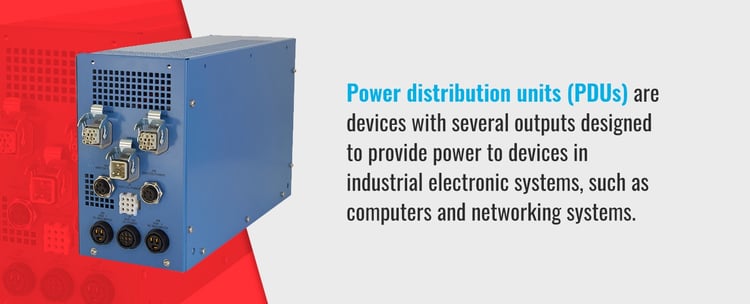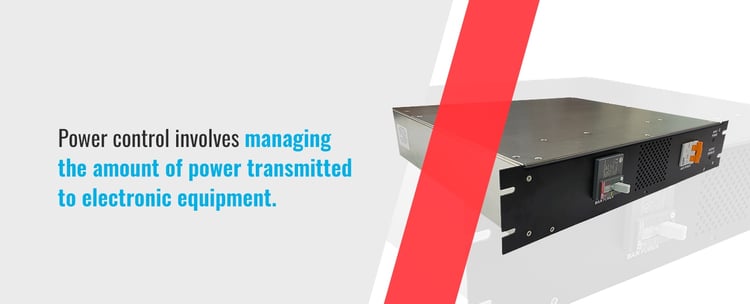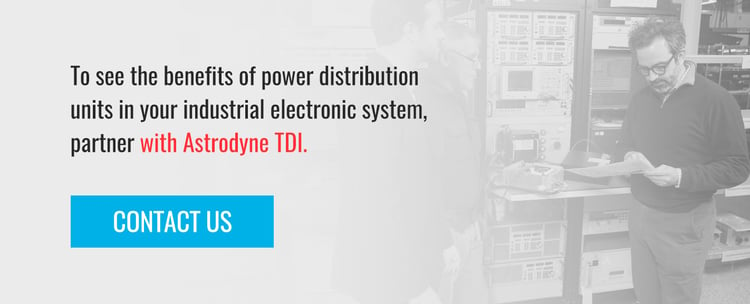RESOURCES
Addressing Power Challenges With Power Distribution Units
Industrial electrical systems face numerous challenges in their everyday operation. Power surges, inefficiency, low uptime and electromagnetic interference, along with other issues, can all diminish their performance.
However, power distribution units (PDUs) can help address power distribution challenges. In this guide, we'll discuss how power distribution units work, what problems power distribution units solve and what power distribution units can be used for.
Click here to download our PDU Product Sheet
WHAT IS POWER DISTRIBUTION MANAGEMENT?
Power distribution management is the process of controlling the amount of electrical energy used to power the devices used in industrial electronic systems.
Power distribution management helps control the power flow and allows the devices and facilities to continue functioning as usual. Power distribution management also allows electronic equipment and systems to switch to different modes that help conserve different amounts of power. These modes can be selected according to the performance needs of the devices.
So, what type of equipment requires power distribution management? Semiconductor fabrication equipment, industrial equipment, computer banks, satellite communications systems, electronic devices in automobiles, and similar products can all make use of this technology.
In some cases, features for power distribution management are built into specific devices. With consumer electronics like laptops, the computer's preinstalled firmware handles power management — but larger systems require additional hardware.
Power management involves several discrete functions:
- load division
- voltage matching
- frequency control
- load sharing
- synchronization
Power distribution then distributes the managed power to large numbers of electronic devices via a system that helps ensure safe, efficient, reliable operation. It allows electronic devices to work constantly, increasing their uptime to make them more productive.
THE NEED FOR POWER DISTRIBUTION UNITS IN POWER DISTRIBUTION MANAGEMENT

What does a power distribution unit do? How do power distribution units work, and how are they used in electronic systems?
Power distribution units (PDUs) are devices with several outputs designed to provide power to devices in industrial electronic systems, such as computers and networking systems. The core uses of power distribution units include controlling the flow of electric power, so the equipment doesn't receive too much or too little.
So, why are power distribution units used? Some industrial uses for power distribution units include manufacturing, medical, aerospace, semiconductor and military applications. They help boost power protection and management. They help facilities increase their efficiency, boost system reliability, and optimize performance.
Two important types of PDUs to note are high-power PDUs and low-power PDUs:
- HP power distribution units: High-power PDUs have a higher power factor, which means they can run higher voltages at lower currents. They use smaller cables, take up less space and help lower costs. Medical uninterruptible power supply (UPS) PDUs are a good example.
- LP power distribution units: Low-power PDUs have a lower power factor and cannot run higher voltages at lower currents. They are reliable and account for the majority of the global market share for PDUs, but they lack high-power PDUs' advantages in space and cost savings.
BENEFITS OF PDUS IN POWER DISTRIBUTION MANAGEMENT
Industrial electronic systems face several common power distribution challenges that the use of PDUs helps mitigate. Below, we'll discuss some of those issues and the advantages of power distribution units.
1. POWER CONVERSION

One of the core uses of power distribution systems involves power conversion. Power conversion changes a particular power configuration into a form that electrical equipment can use more easily. A power plant might supply power in a specific form, but the computer banks downstream might require their power in a different form.
Here are the four basic types of power conversions:
- AC to AC: AC to AC conversions change alternating current by giving it a different voltage level — one the downstream application, like a communications network, can use. These conversions typically require a transformer. The transformer can also work to change the initial power configuration to a configuration the electronic application can use, such as wye configuration.
- DC to DC: DC to DC conversions alter direct current by changing its voltage. If the current comes from the power facility at too high a voltage for the downstream application to use, it becomes necessary to convert the current, so it flows through outputs at a lower voltage.
- AC to DC: AC to DC conversions turn alternating current into direct current, so facilities can run electronics that require DC power when only AC power is available. This conversion typically requires a power supply.
- DC to AC: DC to AC conversions turn direct current into alternating current. This conversion generally requires an inverter, and it allows facilities to run electronics that require AC power when only DC power is available.
One of the benefits of power distribution units is that they allow for power source conversions between AC and DC or DC and AC as they distribute power to electronics. They can also help convert voltages into more usable levels for industrial electronic systems.
2. POWER CONDITIONING
Power conditioning improves the quality of the power that flows to electronic devices and equipment. With a home computer, power conditioning often comes in the form of a surge protector. But for industrial electronic systems, more sophisticated equipment becomes necessary to help deliver the correct voltage and prevent surges and signal problems throughout the system.
Power conditioning units take in power from the power company and modify or filter it to meet the requirements of the system that will use it. It then outputs the power at the desired voltage and quality. Many power conditioning units consist of a voltage regulator and other modules that allow for improved power quality, such as transient impulse protection, noise suppression and power factor correction. They may make use of active power filters, which alter power quality through the direct injection of current, or passive power filters, which make use of components like capacitors, inductors and resistors.
So, why is all this conditioning necessary? Signal problems associated with low power quality often affect much of the wiring in a facility and result in performance issues. They can cause voltage spikes, surges, sags, high-frequency noise and transients that can lead to lockups, false readings and system damage. Using power conditioners throughout an industrial electronic system facility helps prevent signal problems and alleviate these impacts.
How are power distribution units used in power conditioning? Industrial power distribution units can help by incorporating elements of power conditioning units to condition the power flowing through them before distributing it to downstream equipment. This process helps resolve signal problems throughout an industrial electronic system.
3. POWER CONTROL

One of the essential uses of power distribution units is in power control. Power control involves managing the amount of power transmitted to electronic equipment. It is important because it helps a facility ensure safety and promote redundancy and reliability in industrial electronic systems.
Power distribution units offer several different features to help with power control. These features may include remote ethernet signals, breakers, switches and automated switching between power sources. Incorporating these features directly into the PDU helps make the size, cost and complexity of an industrial electronic power distribution system more manageable, especially when units have varying power requirements.
Mounting switching devices directly onto power distribution units is known as local control. Circuit breakers, for example, are often mounted locally to help control power flow. They help protect circuits by providing switching at the power input, at the circuit's branches or even at the outlets. In some industries, though, it is inadvisable to use circuit breakers for power control in this way because their performance and effectiveness can deteriorate over time.
Instead, facilities can use components like embedded or programmable controllers, relay logic and switches for power control. In intelligent power distribution units, these features can incorporate sensors and external signals to help automate power control and management and reduce work for facility managers.
4. POWER MONITORING
Power monitoring involves measuring different aspects of power to evaluate performance and determine where improvements may be necessary. It helps assess and increase energy efficiency without sending costs soaring or diminishing system uptime or dependability. Power monitoring from the power distribution unit can provide other helpful metrics as well:
- Voltage: Measuring the voltage at the incoming power source helps ensure the electrical system will receive the level of power it requires. Assessing input voltage is essential for ensuring that the unit supplies a safe level of power for the electronic system.
- Current: Measuring the current at multiple points in an industrial electronic system helps assess the total load at the input, in individual circuits, and at outlets. Too much current can trip a circuit breaker, so monitoring current helps keep the system running effectively.
- Time: Measuring the duration of time that the power distribution unit or individual circuits have been receiving power helps inform maintenance requests and scheduling.
- On/off status: Monitoring on/off status can give a facility useful data about which power sources are enabled, which switch choices are selected and which outlets are receiving power.
If the equipment in the electronic system is particularly sophisticated and sensitive, a facility will likely need to monitor a wide array of parameters like harmonics. Monitoring these parameters helps ensure that the system receives the power quality it needs for optimal performance and longevity. Having these metrics available lets facility managers know everything is running smoothly and gives them the ability to take swift corrective action if problems arise. Facilities can also set alerts and set points to help manage minor issues automatically through the monitoring system.
5. POWER SWITCHING
Power switching involves routing power through a switching regulator. Whereas a linear regulator maintains a continuous load current to create a constant load voltage, a switching regulator maintains a constant current flow by chopping the input voltage into smaller chunks or energy and sending them one at a time into the output.
Industrial electronic systems often use power switching because switching regulators are more efficient — offering 70% to 95% efficiency rather than 40% to 70% efficiency of linear regulators. They can allow for smaller, lighter and quieter systems.
Power switching can be direct or indirect. Direct power switching sends the power line directly through the switch. Direct power switching is most common for industrial electrical systems that use DC power sources. It is also the most common method for currents of 15 amps or less and AC power sources of 120 volts or less.
Indirect power switching, on the other hand, keeps the power line separate from the control panel. For this reason, it is often used with higher voltage and amperage. In this setup, instead of going directly through the switch, the power line runs through a contactor, mechanical relay or solid-state relay. The control switch is separate — it may be local, separate or connected via another relay.
A power distribution unit often has auto-transfer capabilities that allow for automatic switching.
6. EMI FILTERING
Electromagnetic interference (EMI) can cause tremendous disruption to an industrial electronic system. It distorts the electrical signal out of the ideal sine wave form and can lead to numerous system difficulties, such as reduced equipment performance, operational errors or total failure. EMI filtering helps lessen this hazard.
EMI occurs when one type of electronic signal interferes with another. While filters are occasionally used to protect the device from outside noise, the EMI filter's primary role is preventing noise generated within the unit from exiting onto the power line and disrupting other equipment.
EMI filters typically work through the use of inductors and capacitors:
- Capacitors: Capacitors block direct current — the source of significant amounts of EMI — but allow alternating current through. The shunting capacitors in EMI filters redirect high-frequency currents into inductors.
- Inductors: Inductors are like small electromagnets — they act to retain energy in a magnetic field as a current passes through them. In this way, they lower the voltage of the current. Ideally, the series of inductors in an EMI filter can reduce the EMI to zero, a phenomenon known as shorting to ground.
If the power signal ranges between 50 and 60 Hz, the conductors and capacitors work to divert or block all other frequencies.
Other ways to reduce EMI include shielding, which is common in many electronic applications, and isolation transformers, which are less common and provide for isolated ground and substantial noise reduction.
Effective power distribution units include EMI filters to reduce EMI disruption and optimize industrial electronic system performance.
CONTACT ASTRODYNE TDI FOR ALL YOUR PDU NEEDS
To see the benefits of power distribution units in your industrial electronic system, partner with Astrodyne TDI. We design and manufacture premium-quality custom power distribution units and fit them with a range of EMI filter solutions to enhance their performance. We have extensive experience in working with a variety of industrial, medical, aerospace, semiconductor and military clients, and we are available to answer questions about the purpose of power distribution units in different industries. We want to help you get the PDU you need to solve your industrial power distribution challenges.
Contact us today to learn more.


